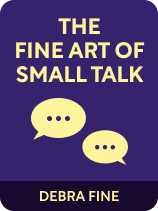

This article is an excerpt from the Shortform book guide to "The Fine Art of Small Talk" by Debra Fine. Shortform has the world's best summaries and analyses of books you should be reading.
Like this article? Sign up for a free trial here .
How do you join in a group conversation without being rude? Is there a polite way to interrupt an ongoing conversation?
Whether you’re at a work party, a family get-together, or a business meeting, it’s important to connect with others. But that’s not always easy when they already know each other or are already engaged in a conversation.
So, here are some tips on how to insert yourself into a group conversation.
How to Break Into a Group
Larger group conversations can be intimidating to break into, it’s easier than it seems. The process is as follows:
1. Stand slightly apart from the group and show interest in the current speaker: Make eye contact, nod along, and so forth. Let the group notice you’re there and warm up to you.
(Shortform note: Before implementing this principle, take a moment to gauge the conversational atmosphere. It’s easiest to enter a conversation with a group when they’re chatting casually. Sometimes, a group will be deeply focused on a serious discussion, in which case it’s best to let them be.)
2. Ease into the group by demonstrating that you’ve been listening. Either acknowledge the speaker or find a point of agreement. Don’t offer a conflicting view right away, Fine warns, or they’ll resent your intrusion.
(Shortform note: Fine explains what to say, but doesn’t cover how to say it—in a large group, it’s hard to get a word in because someone else is always ready to speak up. Here’s how to draw attention and create space for yourself: When the current speaker ends a sentence or thought, take a quick, sharp breath and lift one hand to about chest height as if you’re about to offer the group a pencil. Your intake of breath signals that you’re about to speak, and your gesture will draw everyone’s eyes—even the speaker will cede the floor.)
3. Wait for the group to actively include you. Be patient and look for additional welcoming signs, like being asked for your opinion or the group shifting to physically include you, before you say too much more.
(Shortform note: Fine doesn’t discuss what to do if the group doesn’t include you. If the conversation continues without anyone acknowledging your presence, don’t hover; it’s clear your intrusion is unwelcome. Back off and find another conversation to join.)
How to Interrupt an Ongoing Conversation
Sometimes, there’ll be a particular person you want or need to speak to, like the host of an event or the leader of a conference, and they’ll already be engaged in a conversation. In this case, Fine says, don’t just stand around and wait to be noticed. The other person’s conversation might be so interesting that they never notice you, and you’ll end up wasting time and feeling awkward.
(Shortform note: Another (arguably more severe) consequence of simply waiting around to be noticed is that it may give you a bad reputation. Awkward hoverers are often perceived as creepy lurkers, despite their best intentions.)
Instead of standing around, Fine recommends you wait patiently for a break in the conversation and ask permission to intrude. You might say, “excuse me, I’m Jane Smith—could I cut in for a moment?” In most cases, people will be too polite to deny you, and you’ll be left with two options:
1. Involve yourself right away. Say what you want to say politely: Comment on the topic at hand, state your need, or ask your question.
(Shortform note: This particular tip is best applied in cases where you already know one or both conversationalists—it’s probably okay to intrude on a friend’s chat in this way. However, when you add yourself to, say, a business acquaintance or seminar leader’s conversation, you risk looking rude, domineering, or selfish if you try to immediately monopolize the floor. Therefore, if you’re interested in talking to a professional acquaintance or someone you don’t know well, implement Fine’s next suggestion instead of this one.)
2. Ask for an opportunity to connect with them later. In this case, you’ve made your presence and interest known without being overly intrusive, and you’ve given the other person the luxury of choice. If they like, they can include you immediately—otherwise, they can come find you when they’re done.
(Shortform note: To further minimize the chances of your interruption seeming intrusive or rude, keep it short and be polite. State your need clearly and concisely, and let the other person get back to their conversation as efficiently as possible. Thank them for allowing the interruption and back off immediately.)

———End of Preview———
Like what you just read? Read the rest of the world's best book summary and analysis of Debra Fine's "The Fine Art of Small Talk" at Shortform .
Here's what you'll find in our full The Fine Art of Small Talk summary :
- Why we need small talk and why we shouldn't avoid it
- How to appear confident and engaging in any context
- How to break the ice with strangers and keep the conversation going






